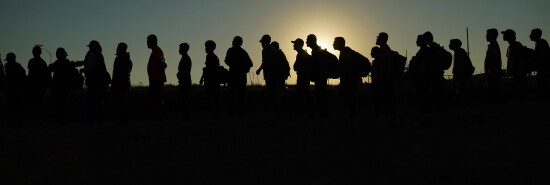
The US-Mexico border is now of critical counterterrorism concern
Tom Rogan
Video Embed
Key illegal crossing areas of the U.S.-Mexico border are effectively open and unsecured. This has been the situation for at least the last 12 months, leading to vast numbers of immigrants entering the United States and relocating across the nation.
The vast majority of these immigrants seek better lives for their families. But some come in pursuit of criminality and a lesser number for terrorist purposes. FBI Director Christopher Wray has signaled increasing alarm to this terrorist threat concern, noting that the FBI is looking for terrorists who are hiding on U.S. soil.
ARIZONA BORDER CROSSING CLOSES IN RESPONSE TO SURGE OF THOUSANDS OF ILLEGAL IMMIGRANTS
On Tuesday, Wray responded to a question from Sen. Lindsey Graham (R-SC), who noted that the terrorism alert lights “were blinking red” before Sept. 11, 2001. Graham asked Wray if he saw a similar situation now. Wray responded: “I see blinking lights everywhere I turn. … The threat level has gone to a whole another level since Oct. 7 [the date of Hamas’s attack on Israel].” While attack plots by “lone wolf” actors inspired to support Hamas are driving many FBI field office investigations (and similar counterterrorism efforts in Europe), I understand that the FBI’s southern border-related concern centers on two other considerations.
The first consideration includes escalated efforts by Salafi-jihadist terrorist groups such as the Islamic State and al Qaeda to take advantage of the sustaining lack of security at the southern border. The second consideration includes new infiltration efforts by Iran’s Islamic Revolutionary Guard Corps, its proxies, and the Lebanese Hezbollah. This is the most pronounced external infiltration counterterrorism concern (including in Europe). For one, IRGC/Hezbollah operatives know how to mitigate their detection by U.S. counterterrorism efforts. Their officers also maintain long-established links with cartels and other criminal enterprises across Latin America who can provide them with transport, forged identity documents, and other means of entering and remaining undetected on U.S. soil. Hezbollah also has numerous sympathizers and logistics nodes established on U.S. soil.
Significant U.S. counterterrorism concern is centering on the possible pre-staging of operatives on U.S. soil for attacks that could be carried out if the Israel-Hamas war expands to include Israel and Hezbollah and potentially Israel and Iran. Indeed, that Iran is attempting to infiltrate a largely unprotected U.S. border is useful in and of itself for Tehran. It allows Tehran to dangle “what if” threats to deter tougher U.S. action against Iranian interests in the Middle East.
This threat isn’t new, even if it is now escalating.
Iranian-directed operatives have repeatedly sought to infiltrate across the U.S.-Mexico border in pursuit of both assassination plots and mass casualty attacks. The Department of Homeland Security says more than 150 foreign nationals who match those listed on the terrorism watch lists were detained between Sept. 2022 and Sept. 2023. But that’s only those who were detained and who could be matched to watch lists.
That the Biden administration is reticent to improve security at the southern border is strange for reasons of counterterrorism but also politics. After all, if a future attack does occur and those responsible are found to have infiltrated the border, President Joe Biden’s reelection prospects won’t prosper for it.
